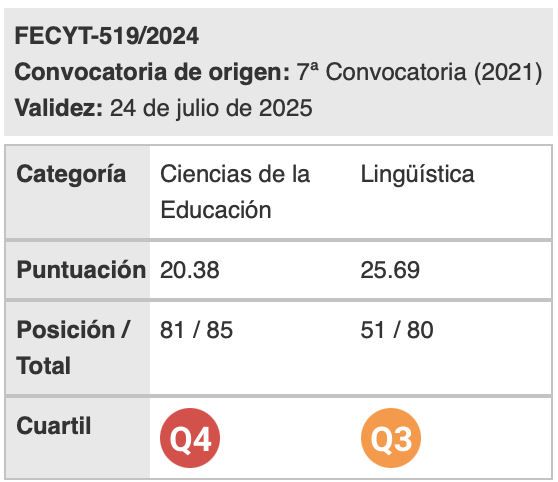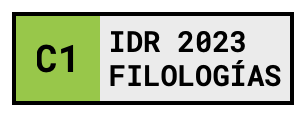An Action-oriented Approach to Didactic Audio Description in Foreign Language Education
Palabras clave:
traducción audiovisual, enseñanza de lenguas extranjeras, enfoque orientado a la acción, competencias de producción recepción y mediación, proyecto TRADILEXResumen
Este artículo expone los principios fundamentales del enfoque orientado a la acción del proyecto TRADILEX (Traducción Audiovisual en el Aprendizaje de Lenguas Extranjeras) que financia el Ministerio de Educación, Ciencia e Innovación de España y que reúne a investigadores de doce universidades europeas y británicas. El objetivo de TRADILEX es el de reunir los datos necesarios para estudiar la mejora de las habilidades lingüísticas con el uso de subtitulado (tanto inter como intralingüístico) y doblaje (así como las voces superpuestas y la audiodescripción) con un enfoque orientado a la acción. La propuesta metodológica, compuesta de tareas de traducción audiovisual (TAV) que se presenta busca que el estudiante pueda progresar en el desarrollo de sus competencias comunicativas, así como en sus destrezas de recepción, producción y mediación lingüísticas, de una manera integrada. Dicha metodología se encuentra actualmente en fase de pilotaje con estudiantes adultos de niveles B1 y B2 de inglés como lengua extrajera y ajusta a los descriptores publicados recientemente por el Consejo de Europea (2008) a la enseñanza de la TAV. Con este artículo, se examinan las posibles ventajas de la enseñanza de la TAV desde un enfoque orientado a la acción en el marco de la enseñanza de lenguas extranjeras. El proyecto persigue, en última instancia, una mayor integración de la TAV en los programas de lenguas extranjeras para el desarrollo de destrezas de mediación y habilidades relacionadas con lo audiovisual a la vez que se promueven las tareas de TAV activas y el uso de tecnologías en el aula.
Descargas
Citas
Baños, R. and Sokoli S. (2015). Learning foreign languages with ClipFlair: Using captioning and revoicing activities to increase students’ motivation and engagement. In K. Borthwick, E. Corradini, and E. Dickens (eds), 10 Years of the LLAS Elearning Symposium: Case Studies in Good Practice (pp. 203–13). Research-Publishing.net.
Bolaños-García-Escribano, A. and Navarrete, M. (2022). An action-oriented approach to didactic dubbing in foreign language education: Students as producers. XLinguae, 15(2), 103–120.
Bolaños-García-Escribano, A. and Díaz-Cintas, J. (2019). Audiovisual translation. In S. Laviosa and M. González-Davies (Eds), The Routledge Handbook of Translation and Education (pp. 207–225). London: Routledge. https://doi.org/ 10.18355/XL.2022.15.02.08
Burger, G. (2016). Audiodeskriptionen anfertigen – ein neues Verfahren für die Arbeit mit Filmen. Info DaF-Informationen Deutsch als Fremdsprache, 1, 44–54.
Caimi, A. (2006). Audiovisual translation and language learning: the promotion of intralingual subtitles. The Journal of Specialised Translation, 6, 85–98.
Calduch, C. and Talaván, N. (2018). Traducción audiovisual y aprendizaje del español como L2: el uso de la audiodescripción. Journal of Spanish Language Teaching, 4(2), 168–180. https://doi.org/10.1080/23247797.2017.1407173
Cenni, I. and Izzo, G. (2016). Audiodescrizione nella classe di italiano L2. Un esperimento didattico. Incontri, 31(2), 45–60. https://doi.org/10.18352/incontri.10169
Chaume, F. (2004) Cine y traducción. Madrid: Cátedra.
Council of Europe (2001). Common European Framework of Reference for Languages: Learning, Teaching, Assessment. Strasbourg: Council of Europe.
Council of Europe (2018). Common European Framework of Reference for Languages: Learning, Teaching, Assessment. Companion Volume with New Descriptors. Strasbourg: Council of Europe.
Gajek, E. and Szarkowska, A. (2013). Audiodeskrypcja i napisy jako techniki uczenia sięjęzyka – projekt ClipFlair. Jezyki Obce w Szkole. Unijna wieża Babel, 2, 106–110.
Díaz-Cintas, J. (Ed.) (2008). The Didactics of Audiovisual Translation. Amsterdam: John Benjamins.
Fryer, L. (2016). An Introduction to Audio Description. London: Routledge.
Herrero, C. and Escobar, M. (2018). A pedagogical model for integrating film education and audio description in foreign language acquisition. In L. Incalcaterra-McLoughlin, J. Lertola, and N. Talaván (Eds.), Special issue of Translation and Translanguaging in Multilingual Contexts. Audiovisual Translation in Applied Linguistics: Beyond Case Studies, 4(1), 31–55.
Herrero, C. and Vanderschelden, I. (Eds.) (2019). Using Film and Media in the Language Classroom: Reflections on Research-Led Teaching. Bristol: Multilingual Matters.
Ibáñez Moreno, A. and Vermeulen, A. (2013). Audio description as a tool to improve lexical and phraseological competence in foreign language learning. In D. Tsigari and G. Floros (Eds.), Translation in Language Teaching and Assessment (pp. 41–61). Newcastle: Cambridge Scholars Press.
Ibáñez Moreno, A. and Vermeulen, A. (2014). La audiodescripción como recurso didáctico en el aula de ELE para promover el desarrollo integrado de competencias. In R. Orozco (Ed.), New Directions on Hispanic Linguistics (pp. 263–292). Newcastle: Cambridge Scholars Publishing.
Ibáñez Moreno, A. and Vermeulen, A. (2015a). Using VISP (VIdeos for SPeaking), a mobile app based on audio description, to promote English language learning among Spanish students: a case study. Procedia - Social and Behavioral Sciences, 178, 132–138. https://doi.org/10.1016/j.sbspro.2015.03.169.
Ibáñez Moreno, A. and Vermeulen, A. (2015b). Profiling a MALL app for English oral practice: a case study. Journal of Universal Computer Science, 21(10), 1339–1361.
Ibáñez Moreno, A., and Vermeulen, A. (2015c). VISP 2.0: methodological considerations for the design and implementation of an audio-description based app to improve oral skills. In F. Helm, L. Bradley, M. Guarda, and S. Thouësny (Eds.), Critical CALL - Proceedings of the 2015 EUROCALL Conference, Padova, Italy (pp. 249–253). Research-publishing.net. https://doi.org/10.14705/rpnet.2015.000341.
Ibáñez Moreno, A., Vermeulen, A., and Jordano, M. (2016a). Using audio description to improve FLL students’ oral competence in MALL: methodological preliminaries. In A. Pareja-Lora, C. Calle-Martínez, and P. Rodríguez-Arancón (Eds.), New Perspectives on Teaching and Working with Languages in the Digital Era (pp. 245–256). Research-publishing.net.
Ibáñez Moreno, A., Jordano, M., and Vermeulen, A. (2016). Diseño y evaluación de VISP, una aplicación móvil para la práctica de la competencia oral. RIED. Revista Iberoamericana de Educación a Distancia, 19(1), 63–81.
Incalcaterra-McLoughlin, L., Lertola, J. and Talaván, N. (Eds.), (2020). Audiovisual translation in language education. In L. Incalcaterra-McLoughlin, J. Lertola, and N. Talaván. Audiovisual Translation in Applied Linguistics (pp. 1–7). Amsterdam: John Benjamins.
Jenner, M. (2018). Netflix and the Re-invention of Television. London: Palgrave Macmillan.
Lertola, J. (2019). Audiovisual Translation in the Foreign Language Classroom: Applications in the Teaching of English and Other Foreign Languages. Research-publishing.net.
Lobato, R. (2018). Rethinking international TV flows research in the age of Netflix. Television and New Media 19(3), 241–56. doi: 10.1177/1527476417708245
Lobato, R. (2019). Netflix Nations. New York: NYU Press.
Luyken, G.-M. (1991). Overcoming Language Barriers in Television: Dubbing and Subtitling for the European Audience. Manchester: The European Institute for the Media.
Malmqvist, J., Hellberg, K. Möllås, G., Rose, R. and Shevlin, M. (2019). Conducting the pilot study: a neglected part of the research process? Methodological findings supporting the importance of piloting in qualitative research studies. International Journal of Qualitative Methods, January 2019. doi: 10.1177/1609406919878341.
Martínez Martínez, S. (2012). “La audiodescripción (AD) como herramienta didáctica: Adquisición de la competencia léxica.” In S. Cruces, M. Del Pozo, A. Luna, and A. Álvarez (Eds.), Traducir en la Frontera. Granada: Atrio.
Navarrete, M. (2018). The use of audio description in foreign language education. In L. Incalcaterra-McLoughlin, J. Lertola, and N. Talaván (Eds.) Translation and Translanguaging in Multilingual Contexts. Special issue of Translation and Translanguaging in Multilingual Contexts, 4(1), 129–50. doi: 10.1075/ttmc.00007.nav.
Navarrete, M. (2020). Active audiodescription as a didactic resource to improve oral skills in foreign language learning [Unpublished doctoral thesis]. Universidad Nacional de Educación a Distancia.
North, B. and Piccardo, E. (2016). Developing illustrative descriptors of aspects of mediation for the Common European Framework of Reference (CEFR). Language Teaching, 49(3), 455–59. doi: 10.1017/S0261444816000100.
Piccardo, E. and North, B. (2019). The Action-oriented Approach: A Dynamic Vision of Language Education. Bristol: Multilingual Matters.
Schaeffer-Lacroix, E. (2020). Integrating corpus-based audio description tasks into an intermediate-level German course. International Journal of Applied Linguistics, 31, 173–192. https://doi.org/10.1111/ijal.12294.
Sokoli, S. (2006). Learning via Subtitling (LvS). A tool for the creation of foreign language learning activities based on film subtitling. In M. Carroll, H. Gerzymisch-Arbogast, and S. Nauert (Eds.) MuTra Multidimensional Translation Conference Proceedings): Audiovisual Translation Scenarios, Copenhagen 1–5 May (pp. 66–73). Copenhagen: University of Copenhagen.
Sonali, R., Greening J. and Petré L. (2010). A comparative study of audio description guidelines prevalent in different countries. London: Royal National Institute of Blind People.
Talaván-Zanón, N. (2011). A quasi-experimental research project on subtitling and foreign language acquisition. In L. Incalcaterra-McLoughlin, M. Biscio, and M. A. Ni-Mhainnin (Eds.) Audiovisual Translation. Subtitles and Subtitling: Theory and Practice (pp. 197–218). Bern: Peter Lang.
Talaván-Zanón, N. (2013). La subtitulación en el aprendizaje de lenguas extranjeras. Barcelona: Octaedro.
Talaván, N. (2020). The didactic value of AVT in foreign language education. In Ł. Bogucki and M. Deckert (Eds.) The Palgrave Handbook of Audiovisual Translation and Media Accessibility (pp. 567–91) London: Palgrave.
Talaván, N. and Lertola, J. (2016). Active audiodescription to promote speaking skills in online environments. Sintagma: Revista de Lingüística, 28, 59–74. https://doi.org/10.21001/sintagma.2016.28.04.
Vanderplank, R. (1988). The value of teletext sub-titles in language learning. ELT Journal, 42(4), 272–281. doi: 10.1093/elt/42.4.272.
Descargas
Publicado
Cómo citar
Número
Sección
Licencia
Aquellos autores/as que tengan publicaciones con esta revista, aceptan los términos siguientes:
- Los autores/as conservarán sus derechos de autor y garantizarán a la revista el derecho de primera publicación de su obra, el cuál estará simultáneamente sujeto a la Licencia de reconocimiento de Creative Commons que permite a terceros compartir la obra siempre que se indique su autor y su primera publicación esta revista.
- Los autores/as podrán adoptar otros acuerdos de licencia no exclusiva de distribución de la versión de la obra publicada (p. ej.: depositarla en un archivo telemático institucional o publicarla en un volumen monográfico) siempre que se indique la publicación inicial en esta revista.
- Se permite y recomienda a los autores/as difundir su obra a través de Internet (p. ej.: en archivos telemáticos institucionales o en su página web) antes y durante el proceso de envío, lo cual puede producir intercambios interesantes y aumentar las citas de la obra publicada. (Véase El efecto del acceso abierto).

Revista de Lenguas para fines específicos is licensed under a Creative Commons Reconocimiento-NoComercial-SinObraDerivada 4.0 Internacional License.























